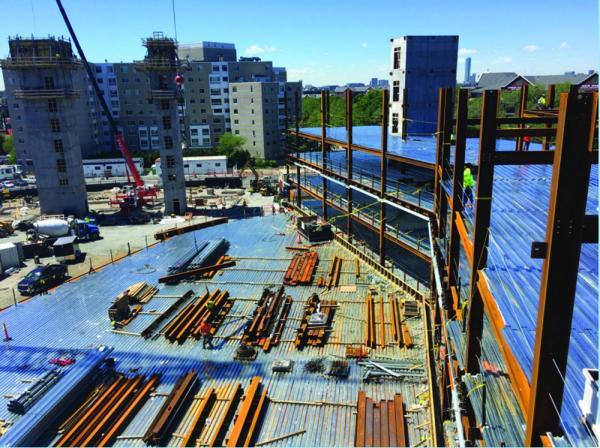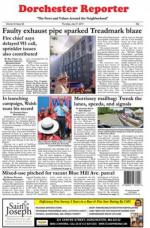June 15, 2017

Workers are making steady progress in building the first-ever student dorms on the UMass Boston campus. UMass Boston photo
Construction is plugging along on the 1,085-bed residence halls at UMass Boston, university officials told a small gathering of community members at the Campus Center last Saturday morning. The two buildings at the “gateway” to the Columbia Point campus off Mt. Vernon Street should be completed in time to open in the fall of 2018, they said.
The lightly attended meeting, held while the Pride festivities swamped downtown Boston, was “one in a series of community discussions,” said Ed Lambert, the university’s vice chancellor for government relations and public affairs.
Having occupied Columbia Point for more than 40 years in its 52-year history, UMass Boston is still seeking to expand its facilities and reputation as the city’s only public research university. Its master plan in 2007 recommended incorporating residential housing, Lambert said, “particularly from the perspective of promoting students success.” About 2,000 beds of on-campus housing was called for in the plan. The new dormitories, their elevator towers now rising over campus dirt piles, will together account for about half of that number.
The dormitory buildings will open the campus near the point where Mt. Vernon Street meets University Drive, between the UMass Boston softball field and the large Lot D parking area.
A larger “East Building” will rise in part to seven stories and ascend further to a dozen stories of residences, containing 804 beds in total. The dorms would partly surround a central one-floor 500-seat dining hall and amenities space. The smaller “West Building” is planned as a nine-story, 281-bed building with first floor common areas. An open courtyard and pass-through sits between the dormitories.
Administrators plan changes for the university to bring it up to a 24/7 standard of campus life, including increasing security staffing, changing operating hours for some amenities and the libraries in moves to bolster research opportunities. Some of these alterations will begin this summer.
“Quite honestly, we’re doing that in a way, through services, to benefit all students,” Lambert said, “not just the thousand students who are going to be living there. That’s a commitment that the university has made. It’s not inexpensive, but we recognize it as necessary for a public research university. And by the way, we are the only public research university in the country without residence halls.”
One attendee raise several questions about the potential student impact on the neighborhood as well as traffic and parking concerns due to construction vehicles parking along the main road. Lambert agreed that the vehicles should not be parked off campus in a way that inhibits other drivers, but he said the school is limited in its authority off UMass Boston property to do more than repeatedly raise the topic and push for better behavior from the construction teams.
On the subject of student life spilling out into the neighborhood, school leaders say having first- year students – and some transfers – living on campus should have a stabilizing effect on them when they move off-campus.
UMass Boston in 2016 counted 4,113 undergraduates and 1,011 graduate students living in the Boston private housing market, both decreases since 2015, according to the city’s University Accountability Reports.
The report notes that the planned dorms align with Mayor Martin Walsh’s push to increase on-campus student housing to relieve the pressure on surrounding private housing markets.
Construction started in November 2016, with pile-driving complete and work under way on the steelwork. The buildings are expected to be substantially complete in July 2018, ready for occupancy that August, according to David Morrissey of Capstone Development Partners, a private developer working with the university on the project.
Villages:
Topics:



